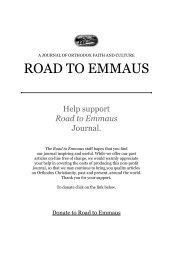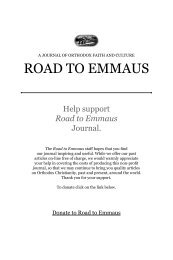RTE No 20 Interior - Road to Emmaus Journal
RTE No 20 Interior - Road to Emmaus Journal
RTE No 20 Interior - Road to Emmaus Journal
Create successful ePaper yourself
Turn your PDF publications into a flip-book with our unique Google optimized e-Paper software.
<strong>Road</strong> <strong>to</strong> <strong>Emmaus</strong> Vol. X, <strong>No</strong>. 1 (#36)TO BE FREE OR NOT TO BEfr. deiniol: In Wales, the <strong>No</strong>rmans established many monasteries. In fact,all the big abbeys were established by them. The most significant thing aboutthis was that, while previously the monasteries had followed the Orthodoxtradition of being independent and generally self-ruling, now each monasteryhad <strong>to</strong> belong <strong>to</strong> one of the Western religious orders. The Welsh oftenchose the Augustinians, as being perhaps the nearest <strong>to</strong> the way of life theywere accus<strong>to</strong>med <strong>to</strong>. There were also many Cistercian foundations in Wales,such as the monastery in Strata Florida. This is where the his<strong>to</strong>ry of Wales,called “The Chronicles of the Princes,” in Welsh, Brut-y-Tywysogion, waswritten. The his<strong>to</strong>ry of Wales begins with the death of St. Cadwaladr, the lastBri<strong>to</strong>n – i.e. Celt, <strong>to</strong> be king of Britain before the Saxons obtained the crown.He is the patron saint of The Wales Orthodox Mission. He was known for hiscompassion, otherworldliness, and generosity – giving away his possessions<strong>to</strong> those who had lost theirs and caring for the multitudes who were afflictedby a terrible plague which visited the land in those days.rte: With such a rich heritage, what allowed the Welsh and Scots <strong>to</strong> makesuch a radical change from traditional Catholicism and a Reformation-imposedAnglicanism, <strong>to</strong> Calvinism?fr. deiniol: By the 18th century, the Anglican Church in Wales was prettymoribund. It was led by English, non-Welsh-speaking absentee Anglicanbishops. Many of the clergy were also absentee and did not speak the languageof the people (by no means everyone in Wales could speak English inthose days).When the Methodist Revival broke out in the U.K. and spread <strong>to</strong> Wales,John Wesley and Whitfield, his colleague, came <strong>to</strong> an agreement that Wesleywould have England as missionary terri<strong>to</strong>ry and Whitfield would take Wales.Methodism spread in Wales through the efforts of great “revivalists” likeHowell Harris, Daniel Rowlands, and especially the magnificent hymnographer,William Williams of Pantycelyn, whose hymns are, by any measure,classics comparable <strong>to</strong> the great hymnographers of any Christian tradition,East or West. Thus, the people of Wales were offered a vibrant and rich religiouslife, in their own language.Methodism became a popular movement – unlike the highly AnglicizedAnglican Church in Wales which was essentially the Church of the landownersand <strong>to</strong> which the ordinary Welsh people may never have been veryattached since the Reformation. The ordinary, poor Welsh people now hada form of Christianity of their own which flourished and produced somegood fruit.However, Whitfield was a Calvinist and so the form of Methodism thatspread in Wales was Calvinistic Methodisim. When a Welsh person speaksof Methodism, he or she generally means this Calvinistic variety also knownas the Presbyterian Church of Wales (the title they prefer these days).Methodism in England followed Wesley’s theology which was based on theteaching of Jacobus Arminius, which emphasizes free will as opposed <strong>to</strong> Calvin’spredestination.Later on, Wesleyan Methodism also came <strong>to</strong> Wales, but it was a minoritydenomination here and strong only in certain specific areas. However, theCalvinists maintain (and I have heard this point being made by a Calvinistminister in my house a few years ago) that the ‘Wesleyans’ have no right <strong>to</strong>be in Wales owing <strong>to</strong> the agreement between Whitfield and Wesley.I must say that the ethos of each of the two forms of Methodism was verydifferent. They had very different cultures from each other. There was evena ditty about the Calvinists: ‘Nasty, cruel Methodists (i.e. Calvinists) who go<strong>to</strong> chapel without any grace....’rte: Have the Catholic and Anglican Churches returned in any force since?fr. deiniol: The Roman Catholic Church, which was illegal for hundredsof years, only returned in the 19th century, although a few “recusant” familieswho could afford <strong>to</strong> pay the fines, remained Catholic. Accordingly, mostRoman Catholics in Wales are not Welsh, but are usually partly of Polishor Irish extraction. There are some Welsh Roman Catholics but they aren’tnumerous.After the rise of Protestant Calvinism, the Anglican Church became a minoritychurch compared <strong>to</strong> the <strong>No</strong>n-conformist denominations such as Baptists,Congregationalists, and Calvinists. Only a small proportion of Welsh-speakingor culturally Welsh people belonged <strong>to</strong> it. This may still be true <strong>to</strong> somedegree. It was only in the <strong>20</strong>th century that the Anglican Church in Walesgained its independence from Canterbury and became disestablished.So, we can say that this is a good time for Orthodoxy as a continuation ofthe Undivided Church, <strong>to</strong> be in Wales. <strong>No</strong>ne of the other churches dominateWelsh religious and cultural life, and people are not so sectarian in theirmentality – it doesn’t mean as much <strong>to</strong> them now that they are Baptists orCalvinists. There is a very friendly atmosphere.2223










